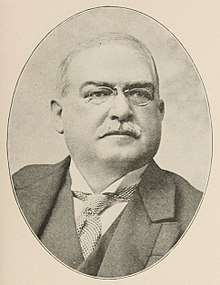Joseph C. Hoagland
Joseph Christoffel Hoagland (June 19, 1841 – December 8, 1899, Manhattan) was the first president of the Royal Baking Powder Company.

Biography
The family began in the Americas with a Dutch settler to New Amsterdam, Dirck Jansen Hoogland, who arrived in 1657. He married Annetje Hans Bergen, the daughter of Hans Hansen Bergen and Sarah Rapalje. (Sarah Rapelje was born in Fort Orange (now Albany) 1625 to Joris Jansen Rapalje [1604-1662] and Catalyntje Trico [1605-1689]. Sarah’s parents had come over from Holland to New Netherland on the first ship to bring the first immigrants to New Netherland in 1624, Sarah was the first woman of European descent born on the island of Manhattan.[1])
Joseph Christoffel Hoagland was born on June 19, 1841 in Ohio to Andrew Hoagland. He had a brother, Cornelius Nevius Hoagland (1828–1898).
In 1865, Joseph Hoagland married Caroline C. Matlack, daughter of John Matlack of Dayton, Ohio. They had three children, Raymond Hoagland (1866–1927), John A. Hoagland and Fanny L. Hoagland.[2][3]
In 1866 Joseph Christoffel Hoagland, his brother Cornelius Nevius Hoagland and Thomas Biddle organized the Royal Chemical Company, which later became the Royal Baking Powder Company. In 1868 they moved to New York, where John H. Seal and William Ziegler became agents of the company and later shareholders.[4][5]
Joseph C. Hoagland lived on Fifth Avenue, and worked at 171 Dwayne Street where he manufactured a brand that made millions of dollars. A culinary revolution was started by the powder that made cake rise and gave it more flavour. Hoagland excelled in marketing and branding their product with such logos such as "absolutely pure" that rendered it better advertised than other bakers. By the close of 19th century Royal Baking Powder was on six continents, a truly international brand. Hoagland was one of the "kings of New York" business world.
He had an acrimonious split with his business partner, William Ziegler in 1888.[4][5][6]
Joseph C. Hoagland died on December 8, 1899.[7]
His great great great granddaughter is Clare Balding, the BBC TV presenter, journalist and jockey.[1]
References
- "Clare Balding". Who Do You Think You Are?. Series 14. Episode 3. 2017-07-20. BBC Television. Retrieved 20 July 2017.
- "Joseph C. Hoagland Dies At His Manhattan Home". The Brooklyn Daily Eagle. 1899-12-08. Retrieved 2017-07-19.
- "John A. Hoagland Dies. Son of Founder of the Royal Baking Powder Co. Dies". New York Times. April 18, 1942. Retrieved 2011-04-30.
His father founded and was president of the Royal Baking Powder Company, for which Hoagland worked in his early manhood. Mr. Hoagland, whose mother ...
- Morrison, Abraham Cressy (1904). The Baking Powder Controversy. American Baking Powder Association. pp. 589–594. ISBN 9781235619861. Retrieved 8 January 2019.
- Civitello, Linda (2017). Baking powder wars : the cutthroat food fight that revolutionized cooking. Urbana, Illinois: University of Illinois Press. p. 45. ISBN 9780252041082.
- "That Baking Powder Suit". New York Times. May 29, 1888. Retrieved 2011-04-30.
The trial of the suit of William Ziegler against Dr. Joseph C. Hoagland, C. N. Hoagland, Raymond Hoagland, and the Royal Baking Powder Company to restrain the Hoaglands from drawing exorbitant salaries as officers of the company was begun before ...
- "In Memory of J. C. Hoagland. Directors of the Royal Baking Powder Company Take Action". New York Times. December 10, 1899. Retrieved 2011-05-01.
As a mark of respect to the late Joseph C. Hoagland, who had for more than thirty years acted as President of the Royal Baking Powder Company, ...